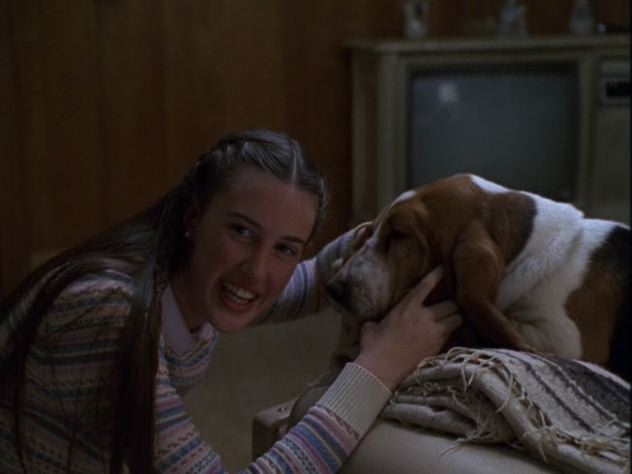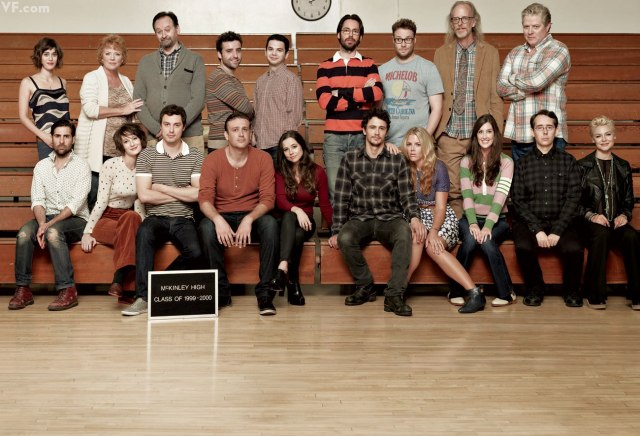Written by Max Thornton. There is a delightful Freaks and Geeks special in Vanity Fair this month, with set photos, a cast reunion, and an interview in which creator Paul Feig discusses what would have happened had the show not been canceled. I recommend savoring all of it, but be warned – you may find yourself compelled, as I was, to hasten to Netflix and marathon the whole series once more.
 |
| The Vanity Fair reunion. |
Not that a Freaks and Geeks marathon takes very long. For the uninitiated, F&G is one of the great unjustly-canned, widely-mourned, single-season shows, right up there with Firefly in terms of squandered brilliance. Set in a Michigan high school in 1980, it focuses on sister and brother Lindsay and Sam Weir and their respective groups of friends, the freaks and the geeks.
To some extent, F&G feels like an improved version of My So-Called Life – not that My So-Called Life couldn’t be charming, or speak the truth of the adolescent condition, but it undeniably succumbed to schmaltz and caricature in a number of ways. Freaks and Geeks nails absolutely everything it tries.
I do wish there were more female characters. Of the eight core characters – five freaks, three geeks – only two are women. The more general lack of diversity, particularly in terms of the overwhelming whiteness and straightness of the characters, can be attributed to the fact that the show is based on Feig’s personal experience of an overwhelmingly straight, white Michigan suburb in the late seventies and early eighties. This, of course, feeds into a larger and still ongoing conversation about whose experiences get put on television; but, assuming we can accept the show’s premise and the whiteness and (ostensible) straightness inherent therein, I still think there could be more female characters.
 |
| Kim isn’t even in this picture, dammit. |
The female characters that are included are fantastic. Lindsay Weir is one of my all-time favorite TV protagonists: blisteringly intelligent and world-weary, yet still a vulnerable and confused teenager searching for an identity and a place, Lindsay kicks off the series with a paradigm shift brought on by her grandmother’s death. Losing her religious faith and quitting the mathletes, Lindsay ditches long-time best friend and inveterate goody-two-shoes Millie in order to befriend the “freaks,” the “burnouts,” a laid-back group of stoners who cut class to hang out and passionately discuss their favorite bands (something that resonates with me personally: I may have attended high school 20-25 years later than these characters, but I was just as enthusiastic about the Who, Pink Floyd, and Rush!). Lindsay doesn’t truly fit in with the freaks, but the more her parents and her guidance counselor and Millie press her on this, the more determined she is to make a place for herself among them.
Lindsay’s place among the freaks becomes secure once she makes a true friend out of Kim, the only other girl among them. The episode in which their friendship solidifies, “Kim Kelly Is My Friend,” was supposed to be the fourth, but was shelved from airing because of its intense subject matter. Lindsay rolls her eyes at her parents’ narrow suburban existence and hopeless squareness, but witnessing Kim’s violent and abusive relationship with her mother causes her to reassess her own life. Most of the freaks have difficult home lives, and they expand Lindsay’s horizons even as she expands theirs. Kim – fierce-tempered and hotheaded, unashamedly sexual, a total spitfire – shows Lindsay that a person’s worth is not dependent on the school system’s assessment of them, but Kim also gains from Lindsay a sense of ambition and motivation.
 |
| “You’re like my only friend, Lindsay, and you’re a total loser!” |
The relationship between Lindsay and Millie is one of the most beautifully observed and painful aspects of the show. Millie, who initially seems like a caricature of the strait-laced goody-two-shoes, proves to be an unfailingly loyal friend who loves Lindsay enough to let her go. In my favorite episode, number 13, “Chokin’ and Tokin’,” Lindsay smokes pot just before a babysitting job, and Millie steps up to care for both the child and an increasingly paranoid Lindsay. During the comedown, the following conversation ensues:
“I love you, Millie. Why aren’t we friends anymore?”
“I thought we were friends.”
“We are. But just, you know, not really. But we’re still the same people we were when we were five. It’s just different now.”
“You’re different now.”
“Yeah, you’re right. But I’m not gonna be different anymore. I’m gonna be the same. And we’re gonna be best friends.”
“You know what, Lindsay? I feel sorry for you.”
“Why?”
“Because tomorrow, when you’re not loaded anymore, you’re not going to believe in God, and you’re not going to want to be my friend anymore.”
It’s heartbreaking.
 |
| Awww, Millie. |
I don’t think Freaks and Geeks has a hidden feminist agenda, but it has a core of real decency and generosity toward its characters. It tries to walk the line of portraying kids honestly, warts and all, without necessarily condoning their behavior. They’re high-school kids; they can be misogynistic, essentialist, bigoted, and the show portrays this honestly, sympathizing for them in their ignorance while gently revealing the flaws in their thinking.
Nowhere is this clearer than in two storylines that dovetail neatly in the penultimate episode, “The Little Things”: geeky Sam’s courtship of his dream girl Cindy, and sarcastic freak Ken’s relationship with Amy. Sam has long been the Nice Guy™, worshiping all-American cheerleader Cindy from afar and slowly becoming the friend she can talk to “like a sister.” When Cindy tires of her jock boyfriend and decides to give Sam a shot, it seems like every little geek’s (and every Nice Guy™’s) dream come true – except that they turn out to have nothing in common, to bore each other, and to have no fun at all. It’s a nifty subversion of what initially seems to be a straightforward idealized Nice Guy™ trajectory from friendship to dating: without any kind of heavy-handed moralizing, the show suggests that the Nice Guy™ routine is not the way to a happy relationship.
 |
| It could never have lasted. Look at the terror on his face. |
Ken, on the other hand, doesn’t spend too much time mooning after Amy before asking her out. They click immediately, and seem very happy together. In pursuit of full disclosure, Amy tells Ken that, although assigned female and comfortable in her gender identity, she was born intersex. Ken reacts the way you might expect a teenage boy ignorant of all things intersex to react: by freaking the fuck out. He worries that this makes him gay (and experiments, hilariously, with disco and a dirty mag) and figures he will have to break up with Amy. It’s only on hearing Sam list the reasons he has to break up with Cindy (“we don’t have anything in common… she thought The Jerk was stupid… we don’t have anything to talk about… she doesn’t like anything that I like… we never have any fun together”) that Ken realizes that he’s being ridiculous.
The handling of the whole intersex storyline is wonderfully sensitive (this episode actually got nominated for a GLAAD award). Ken’s initial insistence that “It’s over, move on” is not how Amy views her intersex status. He has to go through the stages of denying it completely and then letting it take over completely before he can come to acceptance: “I’m sorry, and I don’t care, and I’m sorry.” Had the show lasted, I don’t doubt that there would have been other queer or queer-adjacent storylines, and that they would have been handled with a similar tact and delicacy.
Freaks and Geeks is long dead, but with each rewatch I find new things to appreciate about one of the best television shows ever aired. Long live Freaks and Geeks.
Max Thornton blogs at Gay Christian Geek, and is slowly learning to twitter at @RainicornMax.

